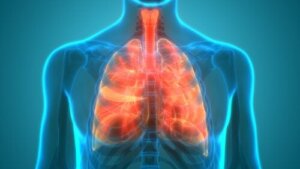The Lung Microbiome: Are The Lungs Sterile?

The pulmonary microbiome tends to be confused with the pulmonary microbiota, but there are nuances between the two concepts. The pulmonary microbiota refers to the set of microorganisms that occupy the airway. However, the microbiome is defined as the set of genes of all these microorganisms. That is, it’s all the genetic material that’s present in the microbiota.
Until recently, the lungs were thought to be sterile organs. However, recent studies have found that this isn’t really so.
In fact, the lung microbiome is gaining in importance. The reason is that it seems to have an influence on numerous pathologies, such as cancer or acute respiratory distress syndrome. Therefore, in this article, we’ll explain everything you need to know.
What is the “Human Microbiome Project”?
Until not so long ago, the lungs were thought to be sterile organs. That is, scientists believed that there were no bacteria or other microorganisms inside them under physiological conditions. However, after the discovery of the gut microbiota, it became clear that this might not be the case.
The Human Microbiome Project, as reported in a publication by Gut Microbiota for Health, was an initiative of the National Institute of Health (NIH). The goal of this project was to identify the microorganisms associated with the human species – that is, all those that interact with the body.
The reason is that it’s known that they can be linked both to diseases and to health itself. This project involved a large investment and lasted a total of five years.
The aim was to test how certain alterations in the human microbiome could interfere with health. They began to study, among others, the pulmonary and intestinal microbiome.
For example, it was observed that the intestinal microbiota had an important and direct relationship with inflammatory bowel diseases. Hence, factors such as diet or even genetics influence these conditions.
Other more specific research began to emerge from the Human Microbiome Project. Each of them aims to demonstrate the association between certain populations of microorganisms in an organ and a specific disease.
How were lung microorganisms discovered?
The Human Microbiome Project was made possible by numerous scientific advances. Techniques such as metagenomics and whole genome sequencing were used to characterize the microbial communities.
The discovery of the lung microbiome was more delayed. This delay was due to the fact that there was a tendency to think that the lungs of healthy people were sterile. In addition, there were certain difficulties in obtaining samples that could be analyzed, since the lower airways are not easily accessible.
However, new technologies were developed that helped to overcome this obstacle. These technologies are based on high-throughput sequencing of the 16S rRNA gene. 16S ribosomal RNA is one of the components of prokaryotic cells.
Therefore, when this gene is sequenced, the phylogeny of bacteria can be reconstructed. In other words, correct bacterial identification becomes possible. This is because most bacteria have a very low rate of evolution. This is explained by a study carried out at the Hospital Clínico de San Carlos.
In short, it was possible to demonstrate that there is a very wide variety of microorganisms in the lungs. All of them contribute to keeping these organs in good condition.
We think you may also enjoy reading this article: 10 Signs That Indicate Your Lungs May Be Failing
Why is the lung microbiome important?
The pulmonary microbiome is of considerable importance. According to a study published in Cellular and Molecular Life Sciences, one of its functions is to promote immune tolerance. In other words, it helps to prevent an uncontrollable inflammatory response.
This prevents lung damage from occurring when in contact with harmless stimuli. The composition of the pulmonary microbiome is also considered to be a determining factor in the development of certain pathologies. For example, in lung cancer. In fact, it not only plays a role in its development, but can also influence the response to treatment.
The same is true for asthma. This is a chronic inflammatory disease that affects the airways. Therefore, the lung microbiome may be one of the triggers or responsible for the attacks.
However, the exact underlying mechanism is still unknown. Allergies and acute respiratory distress syndrome are also associated.
The relationship between the lung and gut microbiome
The gut microbiome has been studied more than the lung microbiome. The reason, as pointed out in a publication of the Spanish Society of Pneumology and Thoracic Surgery, is that it’s more abundant. It’s also easier to obtain samples.
However, the latest research suggests that both microbiomes interact with each other. It appears that both the pulmonary and intestinal microbiomes influence the immune system.
Intestinal microorganisms produce metabolites that exert actions at the pulmonary level. In particular, they synthesize short-chain fatty acids, such as acetate and propionate. Both are derived from the digestion or fermentation of dietary fiber.
These fatty acids help regulate the inflammatory response. Inflammation is a process that triggers our immune system as a defense mechanism. Some people with lung problems have low levels of these fatty acids.
Something similar happens with a bacterium called Helicobacter pylori. It’s a microorganism present in the digestive system of a very high percentage of the population. The bacterium would have a protective effect in children. Colonized children have less risk of suffering from asthma and allergy.
On the contrary, when populations of certain bacterial species in the intestine decrease, there is a greater predisposition to allergy.
How to maintain a healthy lung microbiome
Scientists don’t yet know exactly how to maintain a healthy lung microbiome.
It’s believed that diet, lifestyle, and exposure to certain agents play a determining role. The gut and lung microbiomes are interrelated, as we have already discussed, so taking care of one is also taking care of the other.
The gut microbiota is greatly influenced by what we eat, by probiotics and prebiotics. Having a diet that includes these elements can help boost the immune system and, in turn, improve the lung microbiome.
It’s also advisable to eat an adequate amount of fiber. Digestion of foods rich in soluble fiber promotes the synthesis of short-chain fatty acids.
Like this article? You may also like to read: 4 Vitamins that Help You Heal Your Lungs After Smoking
Why is this discovery important?
Until recently, the lungs were thought to be a sterile organ. However, it’s now known that numerous microorganisms exist there.
Alteration of bacterial populations is associated with different pathologies. For example, it could influence the development and treatment of lung cancer or asthma. So its importance is transcendental for medicine.
However, more research is still needed to know exactly how this balance works. The lung microbiome has opened up new horizons in the possibilities for the treatment and study of chronic diseases of the respiratory tract.
All cited sources were thoroughly reviewed by our team to ensure their quality, reliability, currency, and validity. The bibliography of this article was considered reliable and of academic or scientific accuracy.
- Brenes-Guillén, L. (2019). Proyecto Microbioma Humano. Revista de Biología Tropical, Blog-Blog. https://revistas.ucr.ac.cr/index.php/rbt/article/download/37214/37855
- Fabbrizzi, A., Amedei, A., Lavorini, F., Renda, T., & Fontana, G. (2019). The lung microbiome: clinical and therapeutic implications. Internal and emergency medicine, 14, 1241-1250. https://link.springer.com/article/10.1007/s11739-019-02208-y
- Mao, Q., Jiang, F., Yin, R., Wang, J., Xia, W., Dong, G., … & Hu, J. (2018). Interplay between the lung microbiome and lung cancer. Cancer letters, 415, 40-48. https://www.sciencedirect.com/science/article/pii/S0304383517307607
- O’Dwyer, D. N., Dickson, R. P., & Moore, B. B. (2016). The lung microbiome, immunity, and the pathogenesis of chronic lung disease. The journal of immunology, 196(12), 4839-4847. https://journals.aai.org/jimmunol/article/196/12/4839/105110
- Pereira, C. A. P. (2019). Microbiota intestinal humana y dieta. Ciencia y Tecnología, 12(1), 31-42. https://revistas.uteq.edu.ec/index.php/cyt/article/view/315
- Sommariva, M., Le Noci, V., Bianchi, F., Camelliti, S., Balsari, A., Tagliabue, E., & Sfondrini, L. (2020). The lung microbiota: role in maintaining pulmonary immune homeostasis and its implications in cancer development and therapy. Cellular and Molecular Life Sciences, 77(14), 2739-2749. https://link.springer.com/article/10.1007/s00018-020-03452-8
- Suárez Moya, A. (2017). Microbioma y secuenciación masiva. Rev. esp. quimioter, 305-311. https://pesquisa.bvsalud.org/portal/resource/pt/ibc-167146
- Xu, N., Wang, L., Li, C., Ding, C., Li, C., Fan, W., … & Gu, B. (2020). Microbiota dysbiosis in lung cancer: evidence of association and potential mechanisms. Translational Lung Cancer Research, 9(4), 1554. https://www.ncbi.nlm.nih.gov/pmc/articles/PMC7481604
- Zuo, Z. T., Ma, Y., Sun, Y., Bai, C. Q., Ling, C. H., & Yuan, F. L. (2021). The protective effects of Helicobacter pylori infection on allergic asthma. International Archives of Allergy and Immunology, 182(1), 53-64. https://www.karger.com/Article/Abstract/508330
This text is provided for informational purposes only and does not replace consultation with a professional. If in doubt, consult your specialist.









